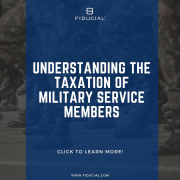TAX BENEFITS FOR MEMBERS OF THE MILITARY
Article Highlights:
Military members benefit from a variety of special tax benefits. These include certain non-taxable allowances, non-taxable combat pay, and a variety of other special tax provisions. Here is a rundown on the most prominent of the tax benefits.
Service Member Residence or Domicile – A frequent question by service members is “What is my state of residence for tax purposes?” since one’s duty station may change multiple times while serving. Luckily, the government passed a law to solve this issue. A service member continues to retain his or her home state of residence for tax purposes, even when required to move to another state under military orders. This also applies to other tax jurisdictions within a state, such as for city, county, and personal property taxes. Thus, a service member will continue to file tax returns for his or her home state and not the state where he or she is stationed.
Service Member Spouse’s Residence or Domicile – In order to simplify the tax-filing requirements of military couples, the Military Spouses Residency Relief Act of 2009 allowed military spouses to claim the same state of domicile as their service member for tax purposes, provided they had also established domicile there.
As an example, say Chris resides in California with his spouse, who is in the military, and Chris has earned income in California but had established domicile with his military spouse in Virginia. Chris would be subject to Virginia income tax laws instead of those of California, and the couple would need file only one state return – in this case, Virginia. They have no obligation to file a California return.
Unfortunately, spouses who had not established domicile in the same state as their service member spouse and who had earned income in the state where their spouse was stationed were still forced to file with both states (assuming both states have income tax).
New for Years Beginning in 2018 – Thanks to the Veterans Benefits and Transaction Act of 2018, an individual married to a military member now has more choices. Under the act, a spouse can elect to have the same state of domicile as their service member spouse, even if they didn’t previously have the same domicile. If the non-military spouse doesn’t make that election, they can continue to choose to file in their own domicile state.
Making these choices can significantly impact the amount of state tax the spouse might have to pay. As an example, a spouse of a service member stationed in a high-income-tax state can elect to use the state of residency of the service member whose residence state has no or low state income tax and not be subject to the state taxes where his or her spouse is stationed.
Careful – It is tempting for a service member or their military spouse to declare their state of domicile to be without any state income tax such as Texas, Nevada, Florida, etc. That can get them in hot water if they do so without any connections to the state.
Non-Taxable Allowances – Members of the military benefit from a number of non-taxable allowances including:
Living allowances – Basic allowance for housing (BAH), housing and cost-of-living allowances abroad whether paid by the U.S. Government or by a foreign government and overseas housing allowance.
Family allowances – certain educational expenses for dependents, emergencies, evacuation to a place of safety and separation.
Death allowances – Burial services, death gratuity payments to eligible survivors, and travel of dependents to burial sites.
Moving allowances – Including for relocation, move-in housing, moving household and personal items, moving trailers or mobile homes, storage, temporary lodging and temporary lodging expenses, and military base realignment and closure benefits.
Travel allowances – Including annual round trips for dependent students, leave between consecutive overseas tours, reassignment in a dependent-restricted status, transportation for military taxpayers and dependents during ship overhaul or inactivation, and per diem.
State benefit payments – Any bonus payment made by a state or political subdivision to any member or former member of the U.S. uniformed services, or to his or her dependent, only because of the member’s service in a “combat zone,” is generally treated as a “qualified military benefit” excludable from gross income.
Other payments – Defense counseling, disability (including payments received for injuries incurred as a direct result of a terrorist or military action), group term life insurance, professional education, ROTC educational and subsistence allowances, survivor and retirement protection plan premiums, uniform allowances, and uniforms furnished to enlisted personnel.
In-kind military benefits – Including legal assistance benefits, space-available travel on government aircraft, medical/dental care, and commissary/exchange discounts.
Combat Zone Exclusion – A member of the U.S. Armed Forces who serves in a combat zone can exclude certain pay from income. This pay includes active duty pay earned in any month served in a combat zone; imminent danger/hostile fire pay; a reenlistment bonus, if the voluntary extension or reenlistment occurs during a month served in a combat zone; accrued leave pay earned in any month served in a combat zone; awards for suggestions, inventions, or scientific achievements the service member is entitled to because of a submission made in a month served in a combat zone; and student loan repayments attributable to the period of service in a combat zone (provided a full year’s service is performed to earn the repayment). Any part of a month in a combat zone counts as an entire month. Periods when one is hospitalized as the result of wounds, disease, or injury in a combat zone are also excluded, provided the hospitalization begins within 2 years of combat zone activities. The hospitalization need not be in the combat zone. Generally, combat pay is not included in the individual’s pay reported on Form W-2.
Commissioned Officers – Commissioned officers may exclude their pay; however, the amount of their exclusion is limited to the highest rate of enlisted pay (plus imminent danger/hostile fire pay received).
Home Mortgage Interest Deduction – Military taxpayers who receive a non-taxable housing allowance and also own a home can deduct the mortgage interest on their home as an itemized deduction, even if they are paid with the nontaxable military housing allowance pay. However, the home mortgage interest is still subject to the general rules for deducting home mortgage interest, meaning that for years 2018 through 2025, only home acquisition debt interest is deductible. Home acquisition debt is debt used to acquire, build, or substantially improve a home. Equity debt interest is no longer deductible for years 2018 through 2025.
Home Property Tax Deduction – Even though they receive a non-taxable housing allowance, a military taxpayer can still deduct their home’s property taxes as an itemized deduction. However, the tax reform limits real property tax and state/local income or sales tax deductions to $10,000 annually for years 2018 through 2025.
Home Sale Gain Exclusion – Most taxpayers can exclude up to $250,000 ($500,000 if filing married joint) of home gain if the home was owned and used as their main home for 2 of the 5 years preceding its sale. However, a military taxpayer may choose to suspend the 5-year test period for ownership and use during any period when the taxpayer (or spouse) serves on qualified official extended duty as a member of the Armed Forces. This means that the 2-year use test may be met even if, because of military service, the taxpayer did not actually live in his or her home for at least the required 2 years during the 5-year period ending on the date of sale.
For this exception to the usual test period, a taxpayer is on qualified official extended duty when at a duty station that is at least 50 miles from his or her main home, or while residing under orders in government housing for more than 90 days or for an indefinite period.
The suspension period cannot last more than 10 years and can be revoked by the taxpayer at any time. The 5-year period cannot be suspended for more than one property at a time.
Example – Sarge bought and moved into a home in 2011 that he lived in as his main home for 2½ years. For the next 6 years, he did not live in the home because he was on qualified official extended duty with the Army. He sold the home for a gain in 2019. To meet the use test, Sarge chooses to suspend the 5-year test period for the 6 years he was on qualifying official extended duty – he disregards those 6 years. Sarge’s 5-year test period consists of the 5 years before he went on qualifying official extended duty. He meets the ownership and use tests because he owned and lived in the home for 2½ years during this test period.
Moving Deduction – The tax reform suspended the moving deduction for all moves except for certain members of the Armed Forces, for years 2018 through 2025. Military taxpayers who are still allowed a moving deduction are those who are required to move because of a permanent change of station. However, the deduction is limited to the actual cost less any non-taxable moving allowance provided.
A permanent change of station includes a move from home to one’s first post of duty when appointed, reappointed, reinstated, called to active duty, enlisted or inducted; a move from one permanent post of duty to another permanent post of duty at a different duty station, even if the service member separates from the Armed Forces immediately or shortly after the move; and a move from one’s last post of duty to home or to a nearer point in the U.S. in connection with retirement, discharge, resignation, separation under honorable conditions, transfer, relief from active duty, temporary disability retirement, or transfer to a fleet reserve, if the move occurs generally within 1 year or the termination of active duty.
Death Gratuity Payments –Military death gratuity payments and amounts received under the service members’ group life insurance program are not taxable to eligible survivors. In addition, these amounts may be rolled over to a Roth IRA or Coverdell education savings account without regard to the limits that otherwise apply to other taxpayers.
Child Credit – Excluded combat pay is treated as earned income for purposes of determining the refundable portion of the child credit.
Earned Income Tax Credit (EITC) – A taxpayer may elect to treat combat pay that is otherwise excluded from gross income as earned income for purposes of the EITC. Making this election for EITC purposes may or may not be advantageous. If the taxpayer has earned income below the maximum amount of earned income on which the credit is calculated, including the combat pay will increase the credit amount. On the other hand, if the taxpayer’s earned income is already in the phase-out range, electing to include combat pay as earned income will decrease the amount of credit that can be claimed.
IRA Contributions – For 2019, individuals can contribute up the $6,000 ($7,000 if age 50 or over) to their IRA accounts, subject to phase-out limits for certain higher-income individuals. However, any contribution is limited to the individual’s earned income for the year. For service members, their combat pay, even though it is not taxable, is treated as earned income for purposes of an IRA contribution.
Reservist’s Travel Expenses – Armed Forces reservists who travel more than 100 miles away from home and stay overnight in connection with service as a member of a reserve component can deduct travel expenses as an adjustment to gross income. Thus, this deduction can be taken even by taxpayers using the standard deduction. However, the expenses themselves are subject to certain limitations. Transportation, meals (subject to a 50% limit) and lodging qualify, but the deduction is limited to the amount the federal government pays its employees for travel expenses, i.e., the general federal government per diem rate for lodging, meals and incidental expenses applicable to the locale and the standard mileage rate for car expenses plus parking and ferry fees and tolls.
Qualified Reservists Pension Withdrawals – Qualified reservists are permitted penalty-free withdrawal from IRAs, 401(k)s and other arrangements if ordered or called to active duty.
A “qualified reservist distribution” is any distribution to an individual if the individual was, by reason of his being a member of a “reserve component”, ordered or called to active duty for a period in excess of 179 days, or an indefinite period and the distribution is made during the period beginning on the date of the order or call to active duty, and ending at the close of the active duty period.
Retired Military Disability Compensation – Disability compensation, as distinguished from retirement payments, are tax free and made by the Department of Veterans Affairs. Some misinformation has circulated indicating that the disability is included in the retirement benefits paid by the Defense Finance and Accounting Services. That is not true since the disability payments are made by the Department of Veterans Affairs and those amounts are NOT included on a Form 1099-R issued by the Defense Finance and Accounting Services.
If you have questions related to military tax benefits, please give this office a call.








Leave a Reply
Want to join the discussion?Feel free to contribute!